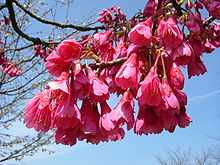Prunus campanulata
From Wikipedia, the free encyclopedia
| Taiwan cherry | |
|---|---|
 | |
| Prunus campanulata blossoms | |
| Scientific classification | |
| Kingdom: | Plantae |
| Division: | Magnoliophyta |
| Class: | Magnoliopsida |
| Order: | Rosales |
| Family: | Rosaceae |
| Genus: | Prunus |
| Subgenus: | Cerasus |
| Species: | P. campanulata |
| Binomial name | |
| Prunus campanulata Maxim.[1] | |
| Synonyms | |
|
Cerasus campanulata (Maxim.) A.Vassiliev[2] | |
Prunus campanulata is a species of cherry native to Taiwan, widely grown as an ornamental tree, and a symbol of Nago, Okinawa in the Ryukyu Islands of Japan. It is variously known in English as the Taiwan cherry,[3] Formosan cherry, or bellflower cherry. It was described in 1883 by Carl Johann Maximowicz.[1]
Invasive species
The tree is an invasive plant species in the Northland Region of New Zealand. It is illegal to distribute, sell or propagate the plant or distribute soil, gravel etc. that contain the seeds or other parts of the plant.[4]
Images
-

Prunus campanulata foliage
-

Two tui in a flowering P. campanulata tree
-

Prunus campanulata young fruit
References
- ↑ 1.0 1.1 "Plant Name Details for Prunus campanulata". IPNI. Retrieved September 14, 2009.
- ↑ "Plant Name Details for Cerasus campanulata". IPNI. Retrieved September 14, 2009.
- ↑ "USDA GRIN Taxonomy".
- ↑ "Northland Pest Management Strategy". Northland Regional Council. Retrieved 12 August 2010.
| Wikimedia Commons has media related to Prunus campanulata. |
This article is issued from Wikipedia. The text is available under the Creative Commons Attribution/Share Alike; additional terms may apply for the media files.